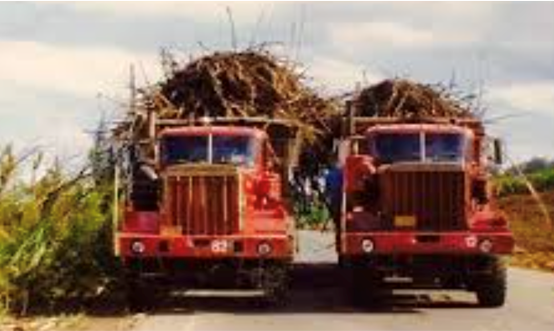Honokaa Sugar Company is located on the northeast coast of the Island of Hawaii approximately 51 miles above Hilo. The northern side of the plantation has an ocean frontage ten miles long bordered by a high cliff. Kahaupu Gulch forms part of the eastern border and Waipio Valley, the western. The lands, which extend from the sea a distance of about three miles toward the mountains, range in elevation from 280 feet at Kukuihaele landing to 1,955 feet inland on the slope of Mauna Kea. The region is cut by a number of gulches and the slopes are generally steep. This presents considerable problems in growing and harvesting cane due to temperature and rainfall variations at different elevations and the problem of transporting it over rough terrain. The search for better varieties of cane has been one of the most important phases of work at Honokaa Sugar Company.
 The history goes back to a predecessor company, Honokaa Sugar Plantation started in 1876 by two men Messrs. Siemsen and Marsden, who began with 500 acres. They planted the first crop in 1876 with the help of Hawaiian laborers and installed a 2-roll crusher mill. This small mill was the first one in the Hamakua area. In 1878, F.A. Schaefer organized a new concern with J. Marsden, J.F.H. Siemsen, J.C. Bailey & M. McInerny. The Honokaa Sugar Company was chartered on May 8, 1878 and Schaefer served as its president for a period of forty years. After the change in ownership, great improvements were made and by 1899 a new six-roller mill was installed making Honokaa Sugar Co. a nine-roller mill. Schaefer organized another sugar firm adjoining the Honokaa Plantation in August 1879 and named it Pacific Sugar Mill. In 1913, Pacific Sugar Mill sold its mill and sent its cane to be ground at Honokaa. At this time, the two companies came under one management, although retaining their separate entities. In February 1928, the two plantations were finally merged into one company under the name Honokaa Sugar Company. The plantation eventually grew to encompass over 9,000 acres, half of it in fee simple lands.
The history goes back to a predecessor company, Honokaa Sugar Plantation started in 1876 by two men Messrs. Siemsen and Marsden, who began with 500 acres. They planted the first crop in 1876 with the help of Hawaiian laborers and installed a 2-roll crusher mill. This small mill was the first one in the Hamakua area. In 1878, F.A. Schaefer organized a new concern with J. Marsden, J.F.H. Siemsen, J.C. Bailey & M. McInerny. The Honokaa Sugar Company was chartered on May 8, 1878 and Schaefer served as its president for a period of forty years. After the change in ownership, great improvements were made and by 1899 a new six-roller mill was installed making Honokaa Sugar Co. a nine-roller mill. Schaefer organized another sugar firm adjoining the Honokaa Plantation in August 1879 and named it Pacific Sugar Mill. In 1913, Pacific Sugar Mill sold its mill and sent its cane to be ground at Honokaa. At this time, the two companies came under one management, although retaining their separate entities. In February 1928, the two plantations were finally merged into one company under the name Honokaa Sugar Company. The plantation eventually grew to encompass over 9,000 acres, half of it in fee simple lands.
In the early days, cane was hauled to the railroad or to the mill by means of mule & horse-drawn wagons. Between 1904 and 1910, two ditches were constructed by Hawaiian Irrigation Co., Ltd. to bring water from the Kohala Mountains and from Wapio Valley. The irrigation company was taken over by Honokaa Sugar Company in 1915. The greatest use of the water was for fluming of harvested cane and the plantation had an alaboate system of flumes for transporting cane from the hillsides to railroad cars. The Company’s railroad system extended over a distance of six and a half miles and in connection with the flumes, offered an effective means of moving cane to the mill.
The mill was connected to the boat landing by an inclined tramway, which transported bags of sugar to the warehouse at the wharf. By means of a wire rope extending down the cliff to a steamer below, sugar was loaded directly onto the ship. In 1919 Honokaa Sugar Co. was able to ship sugar directly to the mainland using this method. Formerly sugar bags were sent by inter-island steamer to Honolulu and reloaded only mainland-bound vessels.
 At the time of Honokaa’s inception, most of the working force was Hawaiian. As the Company grew people from various parts of the world came in this order: Chinese, Portuguese, Japanese, Puerto Ricans, Koreans and Filipinos. A few Russians and Spaniards also worked at Honokaa for brief periods. The plantation furnished for free use about two hundred houses for its employees. The houses were laid out in villages containing outdoor cookhouses, bathhouses, laundries, and running water. Free fuel was also supplied for cooking and heating water. In case of illness, the plantation provided free medical care at its hospital. A Government school, Oriental school and several churches were located nearby. A store and dairy offered staple goods for sale. Later most of the labor on the plantation was performed by contractors, whose earnings were greater, but they did not receive housing.
At the time of Honokaa’s inception, most of the working force was Hawaiian. As the Company grew people from various parts of the world came in this order: Chinese, Portuguese, Japanese, Puerto Ricans, Koreans and Filipinos. A few Russians and Spaniards also worked at Honokaa for brief periods. The plantation furnished for free use about two hundred houses for its employees. The houses were laid out in villages containing outdoor cookhouses, bathhouses, laundries, and running water. Free fuel was also supplied for cooking and heating water. In case of illness, the plantation provided free medical care at its hospital. A Government school, Oriental school and several churches were located nearby. A store and dairy offered staple goods for sale. Later most of the labor on the plantation was performed by contractors, whose earnings were greater, but they did not receive housing.
Honokaa Sugar Company also had the distinction of being the world’s oldest commercial producer of macadamia nuts. The first trees were planted in 1916 as part of a reforestation project at elevations where cane would not grow.
The Honokaa Ranch division was also started in 1916. It consisted of about 2,600 acres of grazing land above the cane fields and 600 head of cattle. Approximately 120 animals were slaughtered each year and the meat consumed locally.
In spite of several severe droughts and continuing problems with plague in the early 1900’s, Honokaa Sugar Company managed to progress in producing low cost sugar. Much credit for this success goes to Mr. W.P. Naquin, Plantation Manager between 1916 and 1944. In 1978, Honokaa Sugar Company merged with Laupahoehoe Sugar Company, a T.H. Davies Company plantation, and became known as Davies Hamakua Plantation Inc. Later on it was bought by Francis S. Morgan and renamed Hamakua Sugar Company.
Sources
Susan M. Campbell
Patricia M. Ogburn
www2.hawaii.edu/
HONOKAA SUGAR COMPANYadmin2021-03-15T18:10:23+00:00
